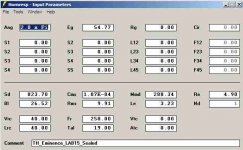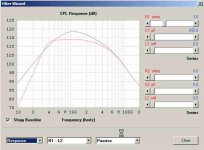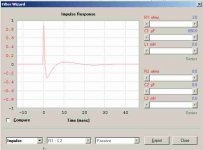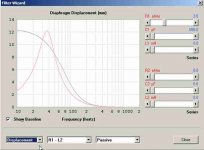I'm getting my feet wet with DIY speakers by building two 15" Stereo Integrity sealed subs. According to WINISD, I'm well within Xmax if I add a 1st order high pass filter at 10Hz.
I've never built any circuits before but schematics for a simple high pass filter look easy enough for my first attempt. It looks like I need a 3975uF capacitor; the highest I see on Parts Express is 500uF.
Two questions:
1. If I use 8 500uF capacitors in parallel, I know that'll give me 4000uF, correct? Are the negatives (other than physical size of the filter) to using that many capacitors together?
2. What dependable vendors sell capacitors like 4000uF? I found some on eBay, but I'd rather not buy there without a recommendation.
Thanks!
I've never built any circuits before but schematics for a simple high pass filter look easy enough for my first attempt. It looks like I need a 3975uF capacitor; the highest I see on Parts Express is 500uF.
Two questions:
1. If I use 8 500uF capacitors in parallel, I know that'll give me 4000uF, correct? Are the negatives (other than physical size of the filter) to using that many capacitors together?
2. What dependable vendors sell capacitors like 4000uF? I found some on eBay, but I'd rather not buy there without a recommendation.
Thanks!
I'm getting my feet wet with DIY speakers by building two 15" Stereo Integrity sealed subs. According to WINISD, I'm well within Xmax if I add a 1st order high pass filter at 10Hz.
I've never built any circuits before but schematics for a simple high pass filter look easy enough for my first attempt. It looks like I need a 3975uF capacitor; the highest I see on Parts Express is 500uF.
Two questions:
1. If I use 8 500uF capacitors in parallel, I know that'll give me 4000uF, correct? Are the negatives (other than physical size of the filter) to using that many capacitors together?
2. What dependable vendors sell capacitors like 4000uF? I found some on eBay, but I'd rather not buy there without a recommendation.
Thanks!
Did you consider active filtering ?
Saves a lot of money and far more flexible
Cheers ,
Rens
Did you consider active filtering ?
Saves a lot of money and far more flexible
Cheers ,
Rens
Yes - I'm considering picking up a miniDSP. I'd like the experience of building the circuit, though. I also like the idea that building the high pass into the cabinet will provide permanent protection for the driver regardless of how I filter it electronically.
A first-order filter will actually supply more power to the driver at resonance.
Speaker-level caps will also be huge, and either go out of spec after a few years, or cost a fortune.
It might not bottom out at LF, but the resultant frequency response would need its own eq. Better just to add an inline capacitor to the input of the amplifier.
Chris
Speaker-level caps will also be huge, and either go out of spec after a few years, or cost a fortune.
It might not bottom out at LF, but the resultant frequency response would need its own eq. Better just to add an inline capacitor to the input of the amplifier.
Chris
A first-order filter will actually supply more power to the driver at resonance.
Speaker-level caps will also be huge, and either go out of spec after a few years, or cost a fortune.
It might not bottom out at LF, but the resultant frequency response would need its own eq. Better just to add an inline capacitor to the input of the amplifier.
Chris
Interesting... that would require calculating the size of the capacitor in relation to the input impedance of the amp, correct?
In my experience and research, you need to make sure you're adding caps that are non polar at worst, if not the polyprop. Even the non polars on PE would mean you're dropping ~64 dollars on building that cap network. Trying active or inline filtering is definitely the way to go. If you're using the method chris suggests, you can save money, but more importantly I think, you can buy a high quality cap and get MUCH better signal tolerance with a polyprop cap for 1/10 th the cost.
Do not stick huge caps in series with the sub. Due to the impedance peaks of the sub in an enclosure, that filtering cannot really work. And yeah, the caps will go bad after a while.
In real life there is vanishingly little program material you can play that would exceed Xmax due just to such a low frequency --> I don't see why you would need 10 Hz filtering at all. Never mind WinISD, it is just a computer program, it is assuming constant voltage sine wave input, but I hope that is not what you are listening to.
If your port tuning was 40 Hz or something, maybe you need a filter up at 40 Hz, although I wouldn't consider that a very optimal design.
In real life there is vanishingly little program material you can play that would exceed Xmax due just to such a low frequency --> I don't see why you would need 10 Hz filtering at all. Never mind WinISD, it is just a computer program, it is assuming constant voltage sine wave input, but I hope that is not what you are listening to.
If your port tuning was 40 Hz or something, maybe you need a filter up at 40 Hz, although I wouldn't consider that a very optimal design.
What kind of amplifiers are you going to use for those subs ? If you get some plate subwoofer amps, they'll include useful settings like subsonic filter, and of course lowpass filter with settable cutoff... If you use a home cinema receiver, some have this functionality, too.
Yeah, I got that part. I guess everyone understands that it isn't a proper solution and that the proper solution is either a powered sub with a sub amp (with all necessary settings) or a cheap active filter and an old amp picked from the pawn shop...
These are not expensive... a passive crossover is useless anyway since you can't adjust the output levels...
These are not expensive... a passive crossover is useless anyway since you can't adjust the output levels...
I have an iNuke NU3000 that will power these drivers in 2 sealed cabinets about 3.5 cf in volume. I'll be using these subs for movies/TV mostly at reference levels - as more movies are mixed with subharmonic sound, I'd like to make sure I don't damage the drivers.
I'm planning to add a capacitor to the RCA cable into the amp. It looks like a 1.5uF cap will do the trick - muuuuuch less expensive.
Now the $50 question - I insert the cap on the signal wire, correct?
I'm planning to add a capacitor to the RCA cable into the amp. It looks like a 1.5uF cap will do the trick - muuuuuch less expensive.
Now the $50 question - I insert the cap on the signal wire, correct?
I'd try experimenting with clip leads and differing values first, but a small cap could be fit in an XLR.Now the $50 question - I insert the cap on the signal wire, correct?
Unfortunately, a single cap will only provide a 6 dB per octave rolloff, which won't do much for limiting excursion, assuming the knee point was -3 dB at 40 Hz, level is down only -9 at 20 Hz.
I'd suggest making at least a 12 dB per octave filter using resistors not dependent on the amplifier input impedance for the crossover frequency.
Too bad you didn't get the DSP equipped unit..
I'd try experimenting with clip leads and differing values first, but a small cap could be fit in an XLR.
Unfortunately, a single cap will only provide a 6 dB per octave rolloff, which won't do much for limiting excursion, assuming the knee point was -3 dB at 40 Hz, level is down only -9 at 20 Hz.
I'd suggest making at least a 12 dB per octave filter using resistors not dependent on the amplifier input impedance for the crossover frequency.
Too bad you didn't get the DSP equipped unit..
Good point - I'll experiment before wrapping it all up. A 1.5uF capacitor looks like it'll be too large to fit nicely in a cable - might have to build a tiny box for it.
The DSP units' filters don't go below 20Hz. If I decide to go with an active unit, I'll pick up a MiniDSP.
Unless WinISD is completely wrong, a 1st order high pass at 10Hz should be enough to keep me under Xmax. Without the filter, I hit Xmax at 20Hz; with the filter at 10Hz, it levels out just under Xmax and drops to about 10% under Xmax at 20Hz and then slopes gracefully down from there. [SI HT 15" D2, wired in series for 4 Ohms, 83 liter sealed cabinet]
Granted, these are my first sub builds, so I don't know how accurate WinISD will be for me.
I look forward to spending some quality time with caps and deep bass.
Hi Y'all,
You don't see large series capacitors much on this forum, but there have been quite a few examples in European forums. They can indeed help to shape the low end, and can be used together w/ a series resistor.
I'm not suggesting that that is the best way to go about this, but it's a possibility. Hornresp has all the functionality to take a look at this type of design, I'll attach an example (this is an example only).
Ok, start throwing rocks.
Regards,
You don't see large series capacitors much on this forum, but there have been quite a few examples in European forums. They can indeed help to shape the low end, and can be used together w/ a series resistor.
I'm not suggesting that that is the best way to go about this, but it's a possibility. Hornresp has all the functionality to take a look at this type of design, I'll attach an example (this is an example only).
Ok, start throwing rocks.
Regards,
Attachments
With a passive filter you'll have to take into account the source and load impedances to have any hope of it working correctly. It would be better to go with an active filter; perhaps the input stage of the power amp could be modified.
Or you could just not worry about it. Not many movies have information down in the 10 Hz range, since few cinemas can reproduce those notes at useful levels. You're more likely to encounter accidental stuff like traffic or air conditioning rumbles.
Or you could just not worry about it. Not many movies have information down in the 10 Hz range, since few cinemas can reproduce those notes at useful levels. You're more likely to encounter accidental stuff like traffic or air conditioning rumbles.
Hi All,
Here is a link to a Posting I made that was supposed for this thread:
http://www.diyaudio.com/forums/subw...ations-acheive-30hz-sealed-2.html#post3782655
b
Here is a link to a Posting I made that was supposed for this thread:
http://www.diyaudio.com/forums/subw...ations-acheive-30hz-sealed-2.html#post3782655
b
hi bjorno - fwiw I just ordered a SI Ht15D2 - got ~6 huge 600uF 600v poly caps laying around - hope this value is useful - or will have to order electrolytics
- should the capacitor - assisted HT15D2 sealed box have stuffing? - what size with fill?
here's an old sim with AJ of a woofer I have
- should the capacitor - assisted HT15D2 sealed box have stuffing? - what size with fill?
here's an old sim with AJ of a woofer I have
An externally hosted image should be here but it was not working when we last tested it.
Last edited:
I would definitely use an active filter before your sub amp.
This would allow you to adjust the cutoff frequency, and make it at least 2nd order(12 Db/octave) although 18 or 24 Db/octave may be better.
You could also have a level (volume) control on your sub.
And a phase control to allow for time delays between the sub and the main speakers.
Active filtering a can sum 2 channels into 1, allow you to select it's Q and it's cutoff frequency.
This is a simple circuit that you could probably find cheaply on the internet or ebay.
Also, you may find that crossing the sub over at a slightly different frequency then the main speakers may help it integrate into the system much more easily.
Most sub plate amps have many if not all of these features.
Dave
This would allow you to adjust the cutoff frequency, and make it at least 2nd order(12 Db/octave) although 18 or 24 Db/octave may be better.
You could also have a level (volume) control on your sub.
And a phase control to allow for time delays between the sub and the main speakers.
Active filtering a can sum 2 channels into 1, allow you to select it's Q and it's cutoff frequency.
This is a simple circuit that you could probably find cheaply on the internet or ebay.
Also, you may find that crossing the sub over at a slightly different frequency then the main speakers may help it integrate into the system much more easily.
Most sub plate amps have many if not all of these features.
Dave
- Status
- This old topic is closed. If you want to reopen this topic, contact a moderator using the "Report Post" button.
- Home
- Loudspeakers
- Subwoofers
- Large capacitors



